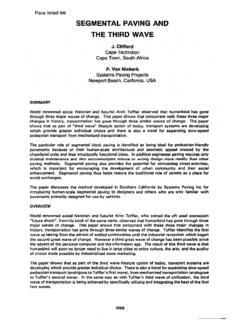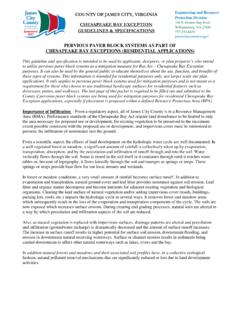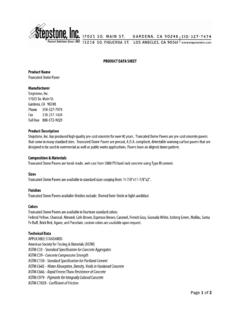Transcription of CONSTRUCTION DETAILS AND GUIDE SPECIFICATIONS FOR ...
1 CONSTRUCTION DETAILS AND GUIDE SPECIFICATIONS FOR interlocking . concrete pavement . Robert J. Burak, Director of Engineering interlocking concrete pavement Institute November 27, 2002. INFRA 2002. November 25-27, 2002. Hilton Bonaventure Montreal, Quebec 1. 1. INTRODUCTION. The concept of interlocking concrete pavement dates back to the Roman Empire. Even then, segmental pavements consisted of tightly fitted paving units on compacted granular base. concrete pavers were developed in the late 1940's in the Netherlands as a replacement for clay brick streets. By the mid 70's automated production was introduced to North America. Today's concrete pavers are manufactured with highly controlled production equipment in controlled environments resulting in paving units with close tolerances to help ensure pavement interlock.
2 The use of concrete pavers for municipal applications is well accepted throughout the world. In North America, the process of institutionalization of the concrete paver began in the mid to late 80's (Smith, 1992). While institutionalization among engineers is still in the development stages concrete pavers are considered an orthodox solution in many applications, particularly heavy load applications. In 1980, the total consumption of pavers in North America for all markets was estimated at 40 million ft2 (4 million m2). For 2001, total sales of pavers in North America is estimated at 430 million ft2 (43 million m2). Commercial and municipal applications account for approximately 32% of the market. The growing acceptance of concrete pavers, is due in part to acceptance overseas as well as acceptance of design methods within the North American engineering community.
3 Internationally, over 5 billion ft2 (500 million m2) are installed annually. This paper will discuss how interlocking pavements function structurally, and how to detail, specify, and construct these pavements for successful performance. Design software for structural calculations will also be discussed. 2. PRINCIPLES OF DESIGN AND CONSTRUCTION OF interlocking . PAVEMENTS. Advantages interlocking concrete pavements offer the advantages of concrete materials, but with flexible performance similar to asphalt pavement . As high strength concrete , the units have high resistance to freeze-thaw cycles and de-icing salts, high abrasion and skid resistance, no damage from petroleum products or from concentrated point loads or high temperatures.
4 Load transfer is achieved through shear transfer through the various joints in the pavement . As with flexible asphalt pavement , an aggregate base accommodates minor settlement, however the difference with the interlocking pavement is that it will not crack. Another advantage to these pavements is access to underground utilities and the ability to re-instate the paving units, thereby reducing waste materials. The results of the life-cycle cost analysis for Main Street, North Bay, (JEGEL, 2000). indicate that when a discount rate of 4% is applied, interlocking concrete pavements are more cost- effective than asphalt pavements for this type of application. Interlock Critical to the structural performance of segmental concrete pavements is the concept of interlock between the units.
5 Figure 1 demonstrates the three types of interlock that must be achieved;. vertical, rotational, and horizontal. Vertical interlock relies primarily on shear transfer of loads to adjacent units through the jointing sand, rotational interlock relies mainly on paver thickness, unit 2. spacing, and edge restraint, and horizontal interlock relies primarily on laying patterns that disperse braking, turning, and accelerating forces. Figure 2 shows a herringbone pattern that is universally recommended for areas subjected to vehicular traffic. Testing has shown that this laying pattern with the use of dentated (or non-rectangular) paver shapes offer the greatest structural capacity and resistance to horizontal creep (Shackel, 1979, 1980). Figure 1: The three types of interlock vertical, rotational, and horizontal Source: interlocking concrete pavement Institute Figure 2: Recommended laying patterns for vehicular traffic Source: interlocking concrete pavement Institute Typical pavement Sections Figure 3 shows typical pavement cross sections for interlocking concrete pavements.
6 The pavers are laid on a one-inch (25 mm) thick sand bedding layer over a compacted bound or unbound base and a granular sub base as required. The base design and sub base requirement are determined by the severity of the applied loads and either the resulting vertical stresses and strains at the top of 3. the subgrade or the horizontal strains in the base. Many pavements for city uses do not require an aggregate sub base except for very heavy use, or over a weak soil subgrade. In these situations it may be more economical to use asphalt or cement stabilized base layers. Often, they are placed over a sub base layer of unbound compacted aggregate. The interlocking concrete paving system also relies on the design and installation of adequate restraint in the form of an edge restraint (ICPI, 1994).
7 The requirement for geotextile application over the subgrade is dependent on the soil conditions. Geotextile may be required to facilitate encapsulation of bedding and joint sands in applications with stabilized bases. Figure 3: Typical Cross sections for interlocking concrete pavements Source: interlocking concrete pavement Institute concrete Paver SPECIFICATIONS concrete pavers are manufactured to CSA SPECIFICATIONS . In this specification , concrete pavers are defined by their aspect ratio (length over thickness) and by their total surface area. A. concrete paver, by definition, must have an aspect ratio less than 4:1 and a surface area less than in2 ( m2). For areas subject to constant vehicular use the required aspect ratio is less than :1 and is assumed for the purposes of this paper.
8 CSA specifies a minimum average compressive strength of 50 Mpa (7250 psi) and includes a durability requirement of a maximum loss of 200 g/m2 of surface area after 25 cycles of freeze and thawing in a 3% saline solution or 500 g/m2 loss after 50 cycles. pavement Materials Compaction of the soil subgrade is critical to the performance of interlocking concrete pavements. Adequate compaction will minimize settlement. For vehicular areas, compaction should be a minimum of 95% modified proctor density according to ASTM D 1157. In extremely saturated or very fine soils stabilization of the soils may be required and geotextiles should be considered. Crushed aggregate bases, or stabilized bases used in flexible asphalt CONSTRUCTION are generally suitable for interlocking concrete pavement .
9 Typically, provincial SPECIFICATIONS fro gradation will 4. be sufficient. The minimum recommended strength requirements for unbound aggregate bases should be CBR=80% and for sub-bases, CBR=30%. Base material should have a plasticity index no greater than 6 and a liquid limit no greater than 25. Compaction of the granular base for vehicular areas should be at least 95% of modified proctor density as determined by ASTM D. 1557, or AASHTO T-180 density. The final base tolerance should be checked with string lines, transit or straight edge and conform to a tolerance of +/- 10 mm over 3 m. Bedding sand should be consistent throughout the pavement and not exceed inches (25 mm). after compaction. The bedding layer acts as the resting spot for the pavers, but more importantly, facilitates initial interlock of the pavers and provides a drainage layer for water that penetrates through the joints.
10 The sand should be as hard as practically available and should not be screening material or stone dust. Screening material will deteriorate after repetitive traffic loading, and both screenings and stone dust will not provide for adequate drainage. These materials will then lubricate, move, and result in deformation (rutting) under loading. ICPI recommends the Liley-Dowson test to determine bedding sand hardness. One (1) kg sample of bedding sand is randomly sampled from the sand source. The sample is dried for 24. hours at 115C to 121 C. Three (3) sub samples, each weighing kg are obtained by passing the main sample several times through a riffle box. A sieve analysis is carried out on each sub sample according to ASTM C 136. Each sample is remixed and placed in a nominal liter capacity porcelain jar with two 25 mm steel ball bearings weighing 75 grams each.









